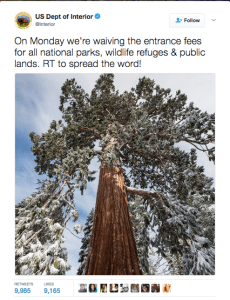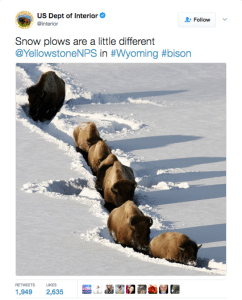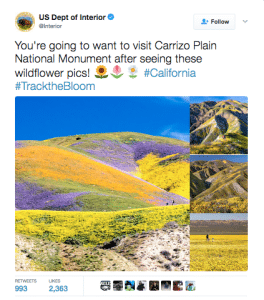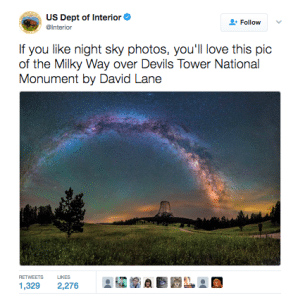
PR pros know it’s important to adapt to change. Yet it’s also comforting when some of the basics of PR can be applied to new platforms. Take Twitter, whose newsworthiness President Trump has cemented. We asked Rebecca Matulka, deputy director of digital, U.S. Department of the Interior, about creating engagement and growing a community on Twitter.
Before setting out the tactics her organization uses, she noted that goal setting, a key component of nearly every PR effort you can think of, should comprise the start of your Twitter endeavors.
“Are you just trying to increase followers? Are you trying to educate followers about your work? Are you trying to get them to take action? Are you trying to humanize” your brand or organization? The goals you choose will have a major influence on the type of community you build, she says.
Interior’s #1 Social Goal
The Department of Interior’s primary goal on social media, she says, “is to get people to love public lands.”
Of course Interior does much more than deal with public lands, but the love of such lands via social media “helps people be interested in the policy, wonky stuff we also do.”
Through social, Interior, Matulka says, has built up an audience that “trusts us and they’ve learned to like us because we provide them with a moment of Zen twice a day. So then our content related to other work” of the Department, “such as tribal relations and energy, is more engaged [with] than other federal agencies.”


Pardon Me While I Zen

“We start our day and end our day on social media with photos of public lands.” The day we interviewed her, the morning photo was of Glacier Bay National Park and Preserve in Alaska. The evening photo was Joshua Tree National Park in southern CA. “We’re trying to not just pick parks, but lands managed by the Fish and Wildlife Service (the Wildlife Refuges) and lands managed by the Bureau of Land Management.”
“It’s all about promoting visitation, exploring public lands or rekindling memories of past visits,” Matulka says. In addition, for people who lack the financial ability or physical mobility to visit these sites, “we’re providing them a glimpse of all these places that we as Americans own.”
The team of Matulka and a colleague works to keep the photos diverse. Although most public lands are in the West, “we try to spread [the locations of the photos] across the country,” she says. In addition, they vary the style of photos, “so they’re not all sunrises or sunsets or night skies…and feature different colors…we think of it as an art gallery.”
While the department uses Google docs to create an editorial grid that plans content in advance, it will react to current events, too. For example, one of its most popular tweets was a photo of a bison in the snow [see photo, above, right]. It was posted last year during a major snowstorm on the East Coast and it did well despite not carrying any of the snowstorm’s hashtags. “It just hit at the right moment,” she says. Another example is the tweet of wildflowers [see photo], which was tweeted when wildflowers were in the news.
Another popular set of tweets publicizes Fee-Free Days [see photo], when entrance fees are waived for visiting public lands. “We ask people to retweet such posts to spread the word…when celebrities retweets them it gives us quite a bump.”
Interior has “different baselines for different content…the public land photos are going to do much better” than policy content or announcements, which are split about 50-50 on Interior’s Twitter account.
In terms of measurement, while Matulka looks at numbers, she prioritizes comments and engagement rates. It’s important “if people care enough to interact with your content…we look closely at the comments…we keep track of comments from users who say we’ve changed their lives.” For example, Matulka has a comment from a couple who said the department’s content “led them to retire early so they could explore public lands.” She also downplays numbers measured quickly. The tweet seen on page 3, far right, was posted more than two years ago and still is receiving hits, she says. “Measurement within 24 hours may not tell the whole story,” she notes.
The average response to the daily photos, she says, ranges from 400-500 retweets and “at least 1,200 likes for a photo.” Due to the popularity of the photos, “our policy work gets about 50 retweets, which is helpful in reaching a larger audience.”
The Department has had rapid growth in its Twitter account in the past few years. It’s at about 3 million followers at present. Growth in the past year has been rapid, she says, possibly because “when Twitter has a new feature we’re one of the agencies that are willing to try it, such as polls or stickers.” As a result Twitter likes to highlight Interior’s content in its best-practices blog posts.


Tips for Building Community
1. It’s not all about you: “We might want to share our policy material all the time,” Matulka says, “but it’s the morning and evening photos that help anchor our content and it’s what our audience wants to see, so we give it to them.”
2. Listen: How do you know what your audience wants to see? “You listen. See how people respond. Read their comments. Even if they’re not responding, that’s helpful because then you know what people like and don’t like.” Adapting your content based on audience response is another key, she says. At the moment, listening is done in platform, in real-time, although “we’re exploring social media management tools.” They use search to find what’s trending and hashtags.
3. Be human: Despite being part of the federal bureaucracy, “We try to have a personal voice for our account…it’s a little bit more informal and less bureaucratic.” @SecretaryZinke’s Twitter account is a great example of this--it includes his personality.
4. Be fans of your community: “We’re constantly listening, tagging others’ content and responding to comments…we want to be people in the community responding to something, not the monolithic federal government responding to something.” An example: About one-third of the photos Interior uses are from users who have visited the sites that are being shown, she says.
5. Don’t be too upset if your post falls flat: Take the knowledge of why it might have fallen flat and use that in the future, so it becomes a learning experience. Speaking of learning, social media is changing constantly. “What works today may not work 2 weeks from now.”
CONTACT: [email protected] @interior
Note: Rebecca Matulka will speak at PR News’ Measurement Conference and Social Media Boot Camp, April 20-21, in Washington, D.C. Information at: http://bit.ly/2mytgRI
